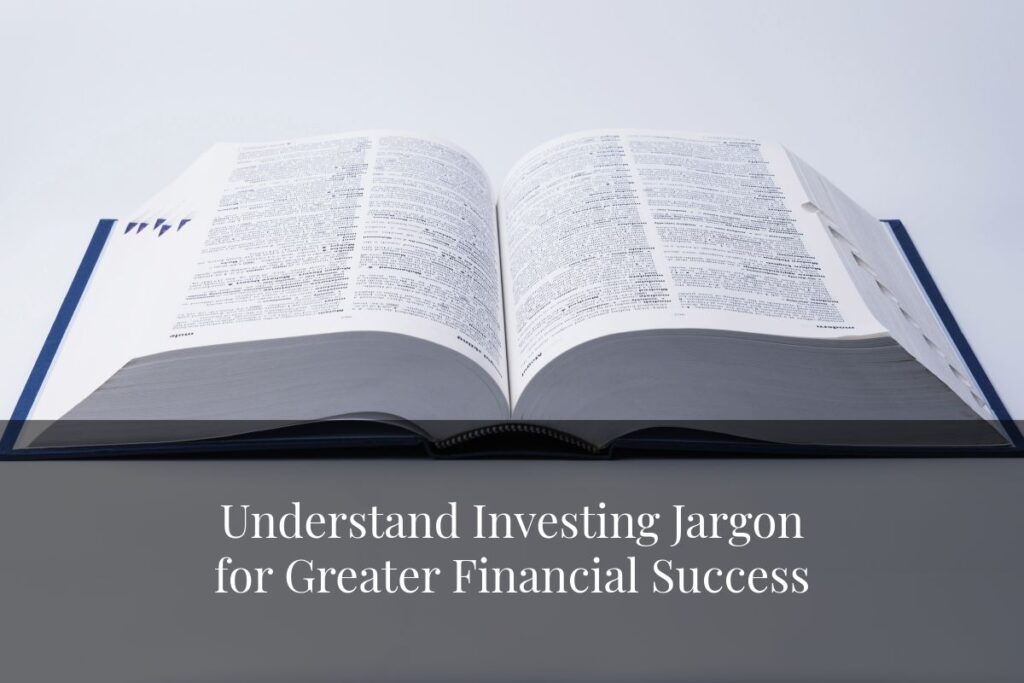Expand Your Financial Knowledge by Learning the Language of the Markets
The world of investing can feel overwhelming, especially when you’re confronted with unfamiliar terminology. If you’ve ever hesitated to dive into the markets because you’re unsure about understanding investing jargon, know that a bit of education can make all the difference. Gaining clarity around these terms can boost your confidence as an investor and help you make more informed decisions about building wealth. In this guide, we’ll cover essential investing terms you should be familiar with.
Asset Allocation
Asset allocation is the mix of securities based on specific asset classes in your investment account. By determining asset allocation, you’re deciding how you want to divide your assets among the three main asset classes which are bonds, stocks, and cash. Each major asset class can be divided even further to determine the sub-asset class allocation based on what you think will work for your long-term financial goals. Typically, your asset allocation will change throughout your lifetime. Unfortunately, a portfolio’s asset allocation can fall victim to a set-it-and-forget-it mentality. Active asset management of a portfolio’s asset allocation is a big key to building and maintaining long-term wealth. An active asset manager will also use their experience in determining which sub-asset classes within each major asset class have the potential to improve your portfolio’s performance in real-time market cycles.
Blue Chip
Stocks issued by some of the most well-established companies that have been around for an extended period of time and have proven they can weather economic downturns can be considered blue-chip stocks. These stocks generally inspire public confidence due to their longevity, and they are often household names. Many blue-chip stocks are also known to pay consistent dividends to their shareholders.
Realized Capital Gain or Loss
A realized capital gain or loss is the difference between the price at which you purchased an investment and the price when you sold it. You’ll want to know this difference to help determine your rate of return on said investment. Realized capital gains carry a tax burden if the security is owned in a taxable investment account while capital losses will generally lower the amount of taxes you owe in a taxable investment account. Realized losses can also be used to offset realized gain taxes for a taxable investment account. An unrealized capital gain or loss is the difference between the price you purchased an investment and its closing price on any given day. Unrealized gains and losses are also known as paper gains or losses.
Diversification
Diversification is critical for investors to understand. It’s the process of spreading your investments across many different major asset classes, sub-asset classes, and types of securities in order to manage your overall risk.
SEE ALSO: Embrace the Power of Diversification to Strengthen Your Portfolio
Dollar-Cost Averaging
Dollar-cost averaging is a strategy that makes it easier to deal with uncertain markets by making automatic purchases. It involves investing the same amount of money in a target security at regular intervals of time over a set time period – regardless of the price. The motivation behind this strategy is that investors can lower their average cost per share while simultaneously reducing the impact of volatility on their overall investment portfolio. Dollar-Cost Averaging also reduces market timing risk due to the consistent purchase schedule.
Index
An index refers to a statistical measure of the performance of a group of assets. Typically, indexes measure the performance of a basket of securities which can replicate a certain area of the market. They are often used as benchmarks to evaluate the performance of an investment. The S&P 500 Index is considered one of the standard bearers of the U.S. stock market’s performance.
Mutual Fund
A mutual fund is an investment vehicle that consists of stocks, bonds, and/or other securities. The allure of mutual funds is that they give small or individual investors access to diversified, professionally managed portfolios. They’re operated by professional managers who allocate the fund’s assets in an attempt to produce capital appreciation and/or income for the investors of that fund. Therefore, each shareholder participates proportionally in the gains and losses of the fund. Mutual funds are priced daily after each day’s market close.
Exchanged Trades Fund (ETF)
An exchange-traded fund is an investment vehicle that consists of stocks, bonds, and/or other securities. ETFs are very similar to mutual funds as they are diversified portfolios overseen by a professional management team. Most ETFs are designed to mimic broad stock and/or bond market indexes both domestically and internationally. ETFs have been evolving over the years to include more actively managed portfolios like mutual funds. ETFs typically carry much lower annualized management fees and are more tax-efficient when compared to mutual funds. ETFs are used by a lot of passive investors looking to match a specific index’s performance. However, a portfolio of ETFs can be actively managed throughout the trading day since they trade like an individual stock or bond.
Risk Tolerance
Risk tolerance refers to the level of risk you’re willing to take on in your portfolio. Investors with a higher risk tolerance are willing to accept greater risk for the chance of higher returns and are typically younger with plenty of time ahead of them to recover any losses they may experience. It’s important to note that risk tolerance is different than your risk capacity, which refers to your portfolio’s ability to take on risk and the length of time it would take to recover from a protracted downturn in value.
Share
A share is a single right of ownership in a company. When a company goes public, it issues shares to investors. The more shares you buy, the greater the ownership stake you have in a company. Shares often come with other benefits, as well, such as the potential for dividend payments and the right to vote in shareholder elections.
SEE ALSO: Mind Over Money: Navigating Investor Psychology Pitfalls
Target-Date Fund
Also known as a lifecycle fund, a target-date fund is a mutual fund that corresponds to a specific year and adjusts its asset allocation as it gets closer to that set date. Many investors choose funds that correspond to the year they hope to retire. These types of funds are prevalent in 401(k) plans.
Valuation
In investing, valuation refers to the analytical process of determining the current, or projected, worth of an asset or company. Investors use valuations when deciding whether to buy a stock, sell a stock, or hold a stock. Valuation is also used during mergers and acquisitions among companies. But valuation is just one of a multitude of fundamentals used by professional portfolio managers.
Better Understanding Investing Jargon Can Lead to Greater Success
It’s human nature to have some trepidation about things we don’t understand, and that can certainly be true of investing. The better you are at understanding investing jargon, though, the more comfortable you’ll begin to feel. Confident, educated investors are usually the ones who can better build their wealth and plan for a financially stable future. Investing is truly key to achieving your long-term goals, and that’s why we believe so strongly in investor education at Davidson Capital Management.
Of course, we offer more than education to our clients. If you’re looking for a partner you can trust to build and actively manage an investment portfolio to serve your unique needs, we’ve got your back. At Davidson Capital Management for the last 35 years, our portfolio management team has provided experienced and transparent investment management with your interests at the forefront of everything we do. Contact us today to begin a conversation about how we can help you make the most of your investments.




